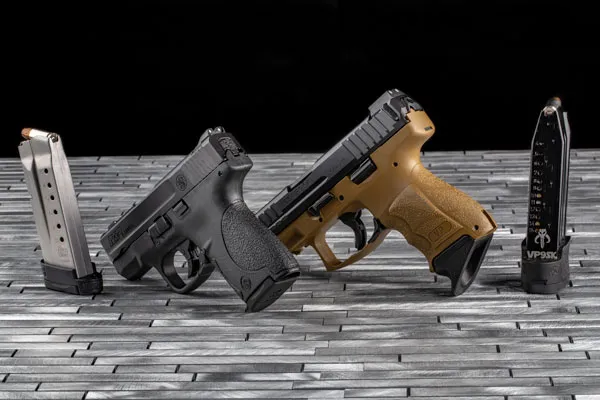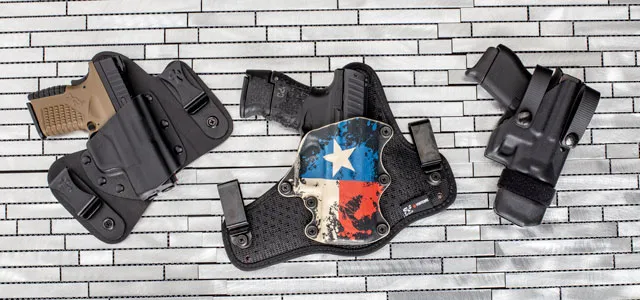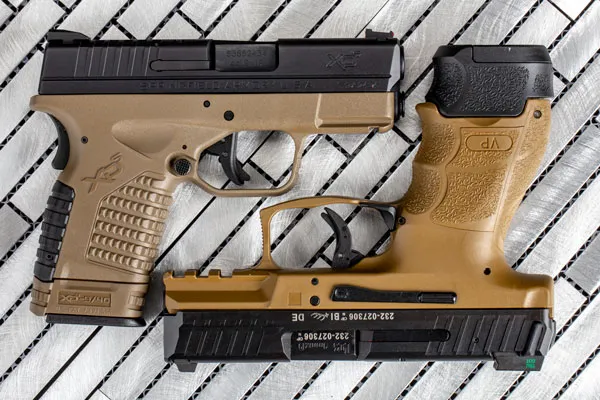The great debates of the firearms community; AR-15 vs AK-47, Striker-Fired vs Hammer, Magazine vs Clip… and now Single Stack vs Double Stack. Which makes for the best subcompact pistol for concealed carry?
Over the past several years, we have seen firearm manufacturers racing to create the smallest 9mm subcompact handgun possible. As concealed carry for personal defense grows in popularity in the United States each year, there has been a movement towards smaller, lighter, and more concealable guns. Handgun size options have expanded from full size, to compact, to subcompact, and even micro.
In the subcompact handguns classification, guns like the Glock 26 and Sig Sauer P320SC are shortened versions of full size guns with a considerably shorter grip. However, they retain the double stack magazines which add to the width of the gun.
Some shooters want smaller guns and the industry has responded over the years with a series of new designs like Smith & Wesson’s 9mm Shield series, Springfield Armory’s XDs series, and the Glock 43 which all use single stack magazines to achieve their smaller size. While these guns provide superior concealability, that comes at a cost of reduced capacity, and potentially accuracy.
The self-defense community has become increasingly polarized as to which of the designs is best. One camp favors concealability and the other capacity. So which type should you get? Unless you’ve dug your heels into one of those camps, what you choose will depend on what works best for you. Let us help you decide.
Shop All Single Stack Sub Compact Handguns
Single Stack Magazines
Single stack magazines are nothing new. In 1893 a German firearms designer named Hugo Borchardt introduced the Borchardt C-93, considered by most to be the first successful semi-automatic pistol that used a detachable box magazine. The magazine was designed so that the 8 bullets stacked precisely upon one another in a single column.

This is commonly referred to as the single stack design and has been used in some of the most historically significant and iconic pistols ever produced, such as the M1911 and the P08 Luger.
Beginning in the early 1900’s with the Savage 1907, staggered detachable magazines made their appearance. The modern version of the double stack magazine was invented by Dieudonné Saive of Fabrique Nationale in the early 1920’s for use in John Browning’s Hi-Power pistol. In this design, the bullets are staggered into two columns allowing for greater ammunition capacity in the same height as a traditional pistol grip.
Larger magazine capacity drove the design. These pistols made no attempt at concealability, as the double column magazine increases the width of the grip. This design is used in many subcompact pistols today, providing excellent carry capacity, but the demand for concealability has risen dramatically.
Double Stack Capacity vs. Single Stack Concealability
When all the echoes of shouted rhetoric from both sides of the battle begin to fade, the crux of the battle is the tradeoff in magazine capacity for what some perceive as a nominal improvement in concealability. Yes, there are arguments that the smaller single stack handguns are more difficult to shoot and, as a result, are less accurate.
But with proper training and dedicated practice – which you should be doing no matter which gun you choose to carry for self-defense – the initial differences can be overcome quickly. What isn’t overcome is the reduction in ammunition capacity between the two types. On average, double stack subcompacts have 3-4 more rounds in a magazine compared to their single stack counterparts.
Double Stack
There is a saying in the firearms community that “I have enough ammo” is something no one will ever say in a gunfight. There are plenty of shooters out there who would not consider carrying anything less than a full-size handgun with at least 15+1 capacity.
If your daily life, job, body type and dress requirements allow you the ability to carry a full-size pistol every day, that is fantastic and this email is not for you. For many shooters that choose to carry concealed, full-size or even compact is not an option, especially in today’s highly sensitive political environment where knowledge of your carrying a firearm could have potentially negative consequences. But smaller guns mean decreased capacity.
Another argument that is heard often from the single stack camp is “if I can’t neutralize a threat in 6 rounds I shouldn’t be carrying.” This is often the result of overconfidence in one’s abilities and a lack of understanding about what happens in a real-world self-defense situation.
For most shooters who are confined to static ranges, the stress, speed and movement associated with a self-defense situation is something they have not had the opportunity to train and practice with live fire. Additionally, there is ample documentation from law enforcement and military engagements where threats have not been neutralized despite multiple hits.

Statistics on rounds fired during civilian self-defense incidents are difficult to calculate as they are not tracked nationally. Several years ago, Claude Werner, a well-regarded firearms instructor, did his own study based on reported self-defense incidents over a multi-year period.
His results showed that statistically, two shots were fired during the average civilian defensive situation. The two-shot number has been widely reported as average rounds fired. This number has contributed greatly to the justification and adoption of the lower capacity concealed carry 9mm pistol.
What Mr. Werner’s study also states, which is frequently overlooked, is that when more than two shots were fired during an incident, most shooters continued to fire until the magazine was empty.
So as a civilian carrying concealed, you are faced with trying to balance average statistics and worst-case scenarios… And bet your life on it. This is a personal decision that you must make based upon your situation, concealability requirements, level of training, and budget. While it is generally preferable to carry a larger capacity gun, it is not always possible or practical depending on your concealability requirements.
What is Concealable to Me is Not Concealable to You
What does concealment mean? Essentially, you want it to mean that no one can discern that you are carrying a firearm. Concealment typically fails when the outline can be seen through someone’s clothing. This is commonly referred to as “printing.”
Some states have aggressive laws regarding concealed carry of firearms where a gun that is “printing” may be construed as exposed and fall under open carry laws which may have significant legal penalties for the individual. Know your laws!
The concealability of a gun is determined by a variety of factors: gun size, magazine size (extended or flush with grip), holster type, holster design, holster location, clothing, and most importantly, body type. Those are a lot of variables, which is why it is important to do your research and not listen to rhetoric from deeply entrenched camps. What works great for one person, does not work great for everyone.
Body Type
Bodies come in different shapes and sizes. Bodies with extra padding can conceal larger firearms at the 4 o’clock right hand or 8 o’clock left hand positions more effectively with the right combination of holster and clothing. That same extra padding may make it prohibitively uncomfortable to position the holster in the appendix carry position, especially when sitting.
A skinny body type, however, may be in the opposite situation where there is difficulty concealing a larger firearm at the 4 or 8 o’clock positions, but appendix carry is easier. Know your body type and be realistic. While “carrying a firearm is supposed to be comforting, not comfortable,” don’t put yourself in a position where discomfort becomes the norm because you chose the wrong firearm, carry position and holster.
If you sacrifice too much in the way of comfort, you may find yourself not carrying as often as you otherwise would.
Size Matters
The single stack subcompact is a smaller gun. For comparison, let’s look at two popular subcompacts.
| # | Glock 26 Double Stack | Springfield XD-S Single Stack |
|---|---|---|
| 1 | Length: 6.41″ | Length: 6.3″ |
| 2 | Width: 1.18″ | Width: 0.9″ |
| 3 | Height: 4.17″ | Height: 4.4″ |
| 4 | Capacity: 10Rd | Capacity: 7Rd |
The Springfield XD-s is 24% thinner than the Glock G26. When combined with a holster and clothing, that 24% reduction in size could very well mean the difference between concealment and “printing.”
Smaller pistols, however, can be more difficult to shoot than comparable larger guns. The reduced mass can often create a gun with greater felt recoil. The smaller grips can be more difficult for different size hands to control.
If the pistol is shorter in overall length, shooters can also experience issues with accuracy because of a shorter sight radius. The combination of these issues can create a situation where a particular gun may not be suitable for novice shooters without dedicated training and practice.
It is common for many firearms retailers to push a novice female shooter, for example, into a small firearm before that shooter has the experience to feel comfortable with the pistol. This leads to a bad experience for the shooter who may have been better served with a larger, more controllable gun.
Holsters
If you are going to carry a firearm, you must use a quality holster that completely covers and protects the trigger. It is highly recommended that your holster be custom fitted to your gun type if possible.
Holsters come in a variety of materials and sizes to accommodate different size firearms and preference. There are a wide array of holster types and styles that can accommodate a pistol, including holsters that are integrated into special undershirts, belly bands, shoulder holsters, and some more exotic customized solutions.
This guide will only focus on the three most common types: Outside the Waistband (OWB), Inside the Waistband (IWB) and Appendix Inside the Waistband (AIWB). Holsters are also designed to be worn on the right side of the body or the left, so be specific when choosing one.

OWB holsters are the least concealable and are typically worn under baggy, untucked shirts and jackets. IWB holsters are worn inside your pants and typically secured by clips that hook over a belt.
Depending on the design, they can be worn at multiple positions around a waist. AIWB holsters are specifically designed for use in the appendix carry position. They may have advanced features that maximize concealability at that position, but would accentuate “printing” if worn elsewhere.
Some holster designs and materials are better than others. Research your holster to ensure proper fit and concealability. Putting a slim Glock 43 single stack pistol into a bulky holster will defeat the purpose for which the gun was designed.
How to Wear a Holster
Where should you carry your concealed carry pistol? First, are you a right or left hand shooter? Next, which position around that side of the body works best for you. Most shooters choose to conceal a firearm at the 4 o’clock right hand or 8 o’clock left hand positions between the hip and the small of the back.
Many shooters vary slightly from here, either towards the back or the hip. For many shooters with smaller body types, the most exposed and uncomfortable option is directly on the side of the body at the 3 or 9 o’clock positions. As you move the holster closer to the small of the back, the position becomes less ergonomic and more difficult to safely draw the pistol and is not recommended.
The appendix carry position at the 1 or 11 o’clock positions has grown in popularity over the last couple years. Some advocates claim it can increase speed and time to target significantly. Detractors, however, claim that a negligent discharge in that area of the body when holstering or unholstering a pistol (accidents happen) can have devastating and fatal consequences compared to the severity of injury in other areas.
No matter the position, holstering your firearm should always be done precisely and carefully – there is no prize for holstering the fastest. It is also recommended to use a quality gun belt that stabilizes the entire carry system.
Many dress belts that you find in department stores will not stay secure and may eventually shift position or roll. When choosing your holster, seek advice from experienced shooters and training professionals. Consider investing in some quality firearms training to improve your skills and safety.
Clothing
The biggest variable that affects concealed carry is clothing. For most shooters that carry for self-defense, concealed carry means wearing a baggy shirt that is untucked. The larger frame pistol can easily be accommodated like this. But what if you work in a job where dress is business casual and you need to tuck in a shirt, but don’t wear a sport coat?
Several holster manufacturers make IWB and AIWB holsters that can be worn with a shirt tucked in. Many shooters believe that they can’t carry a firearm because of dress requirements and often leave a gun at home in certain situations. This is where the single stack subcompact shines. The smaller size may allow for much easier concealment options depending upon clothing and style choices.
Should I Buy Single Stack or Double Stack?

If concealability is your priority, you need to get the proper combination of gun and holster to match your body type and required dress. If that combination lends itself only to a single stack subcompact, then that is the gun for you.
If your concealability requirements can be met with larger capacity pistols, then you have a greater flexibility in your options. If capacity is your priority and you can be flexible with dress requirements, then a double stack subcompact is the way to go.
If you are in a situation where most of the time you are required to use the smallest possible gun for carrying, but there are times where you can be more flexible with your apparel, remember that nearly all single and double stack subcompacts have extended magazines to increase capacity. These higher capacity magazines typically also have grip extensions which provide additional controllability.
One other benefit of double stack subcompacts is their ability to use full-size magazines for reloads. It is also recommended that when carrying a semi-automatic pistol, especially a subcompact, you also carry at least one spare magazine with you because it is always best to be prepared for the worst-case situation. That’s why you’re carrying a gun in the first place, right?
Ultimately, if you choose to carry concealed, your choice in firearm is a very personal decision. It is not a one size fits all proposition and it is up to you to decide which pistol meets your criteria. Whichever type you choose, we highly recommend that you get some training and safely practice regularly with your firearm to not only become proficient, but to master it.



